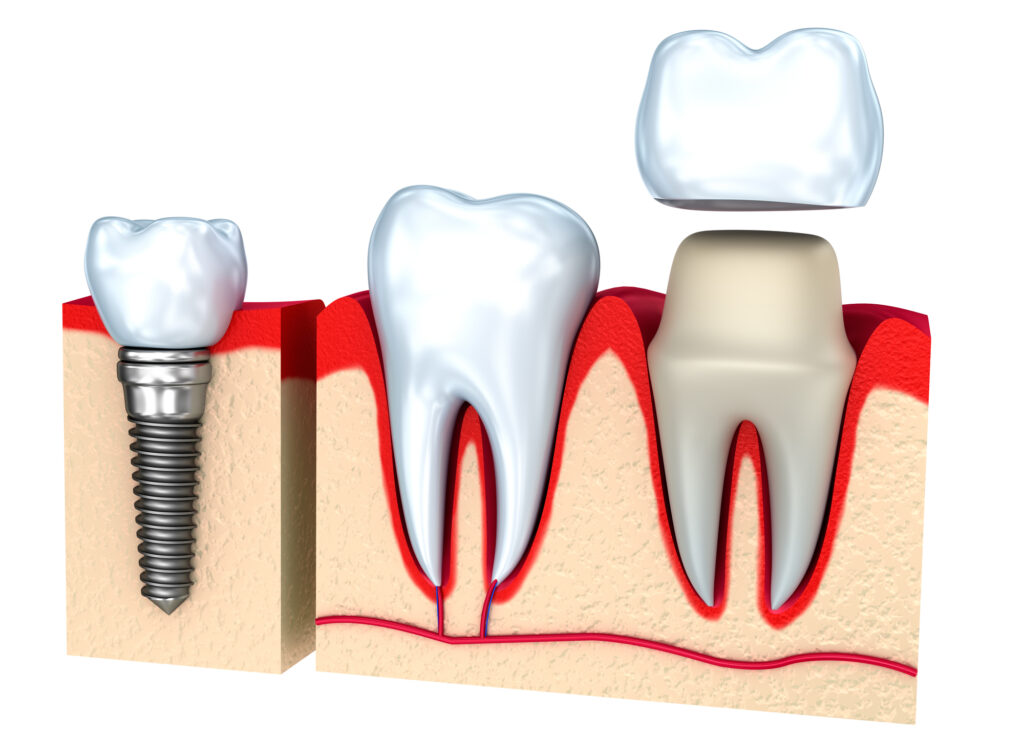
Do you have a severely damaged tooth? In this age of modern dentistry, you have options. But having so many choices can sometimes be confusing. Should you choose a traditional crown? Or is an advanced dental implant the better choice?
The answers to questions like this can be very complex, which is why, first and foremost, you should talk with an experienced dentist. However, here is an overview of the difference between a traditional crown and a dental implant.
Why You Might Need Dental Restoration
Before looking into the differences between implants and crowns, why would you need these procedures in the first place?
Tooth Decay
Cavities, especially when severe, can significantly weaken tooth structure. If the damage is bad enough, a filling is no longer going to cut it. A dental crown or implant may be needed to restore the tooth’s strength and functionality.
Root Infections
An infection in the pulp, or root, of a tooth likely requires root canal therapy (which may warrant a crown) or tooth extraction, depending on the severity.
Cracked or Broken Teeth
Accidents, trauma, or biting on hard objects (food or not) can lead to cracked or fractured teeth. In such cases, a dental crown can be used to cover the damaged tooth.
Tooth Loss
Implants are an option for single-tooth replacement, while implant-supported dentures can replace an entire set of teeth. Similarly, when multiple teeth are lost, either implant or crown-supported bridges may also be an option.
Cosmetic Enhancements
Crowns, and occasionally implants, can be used for cosmetic purposes to improve the look of misshapen or discolored teeth.
Dental Crowns
A dental crown is a prosthesis that is used to replace the outer part of a tooth. They are a custom-made “cap” that encases a damaged tooth, providing structure and protection while preserving a tooth’s root.
Before placing the crown, we prepare your tooth by removing any decay or damaged portions. Then, your tooth is reshaped so that the crown can be affixed on top of it.
When to Choose a Dental Crown
Because a traditional crown is affixed to existing tooth structure, this procedure is only possible if at least a small portion of a natural tooth remains intact and healthy.
Assuming a sufficient portion of your tooth remains, a crown is often the preferable option. Placing a crown is simpler and less costly than a dental implant. Also, because a portion of the living tooth remains, you can often retain feeling in the tooth, even if it is capped with a crown.
Dental Implants
A dental implant is quite a bit more complex than a simple crown. First, an implant can only be placed where a tooth is completely absent. A titanium post that appears similar to a screw is surgically implanted into the bone of the jaw, where a tooth’s root would normally reside. The post is topped with an abutment, which protrudes from the gumline and will support a crown. Just like in the case of a traditional dental crown, the crown for an implant is custom-created to match your natural teeth in color and shape.
When to Choose a Dental Implant
Dental implants are often recommended when no tooth structure remains. When an entire tooth (or teeth) needs to be replaced, an implant is often a superior option to bridges or dentures because the base of the implant will aid in preserving jaw structure.
Dental implants are a preferred choice for replacing a single missing tooth without affecting neighboring teeth. In addition, implants can also be used to support dental bridges, which replace multiple missing teeth. For those patients missing an entire arch of teeth, implant-supported dentures can provide a secure and permanent solution.
Choosing the Right Restoration
Both dental implants and dental crowns serve vital roles in restoring your smile. The decision between a dental implant and a crown depends on your unique circumstances. Contact our office today to schedule a consultation and determine the most suitable treatment plan for your specific case.